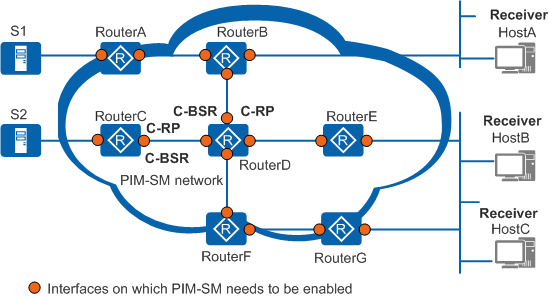PIM-SM Application in a Single AS
Figure 1 shows multicast services deployed on a large-scale network. The Interior Gateway Protocol (IGP) is running on the network and all network segments are reachable. Multicast group members are sparsely distributed. Hosts on this network want to receive VoD information, and network bandwidth needs to be used efficiently.
Implementation Plan
HostA, HostB, and HostC are receivers of multicast video streams. The entire PIM domain runs PIM-SM. RouterA connects to multicast source S1, and RouterC connects to multicast source S2. RouterB connects to the network segment of HostA. RouterE and RouterG connect to the network segment of HostB and HostC.
The network deployment must meet the following requirements:
PIM-SM must be enabled on all router interfaces.
The core router closest to the multicast source is used as a C-RP because multicast sources are densely distributed. The interfaces of RouterC and RouterD are configured as the C-BSR and C-RP. The BSR and RP are elected dynamically.
Recommended RP deployment is as follows:
On small- and medium-scale networks, configure a static RP because of its stability and low requirements on network devices.
If there is only one multicast source, use the router directly connected to the multicast source as a static RP so that the source DR does not need to register with the RP.
If a static RP is deployed, all routers including the RP in the same domain must be configured with the same RP information and the same range of multicast groups.
On large-scale networks, use a dynamic RP because of its high reliability and ease of maintenance.
If multiple densely distributed multicast sources exist on the network, a core device close to the multicast sources is used as the C-RP. If there are multiple densely distributed group members, a core device close to the group members is used as the C-RP.

To ensure consistent RP information in the PIM domain, use the same type of RP (static or dynamic) on all the devices.
IGMP must run between the routers and hosts on a shared network segment (between RouterB and HostA, and between RouterE/RouterG and HostB/HostC).
All router interfaces on the same network segment must run the same IGMP protocol version and be configured with the same parameter settings, such as the query interval and timeout period of group memberships. If IGMP versions or parameter settings are inconsistent, IGMP group memberships on routers will be different.
After the network is deployed, HostA, HostB, and HostC send Join messages to the RP based on service requirements, and multicast data sent from the multicast source can reach the receivers.

To improve the stability of multicast services, statically add edge interfaces to multicast groups requested by users.
